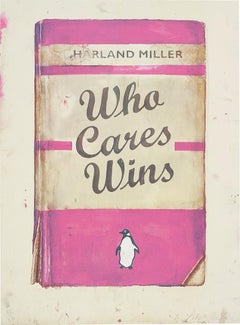Harland Miller Who Cares Wins
Recent Sales
2010s More Prints
2010s Interior Prints
Lithograph
Harland Miller for sale on 1stDibs
Harland Miller is a British artist and novelist, born in 1964, in Yorkshire, England. He is best known for his satirical paintings of re-imagined Penguin classics, often with his invented sardonic titles. He takes artistic influence from Ed Ruscha, Anselm Kiefer and Robert Rauschenberg and cites Mark Rothko as one of his favorite artists. He attended the Chelsea College of Art, in London, from where he received his BA and MA degrees, after which he traveled extensively, living in New York, New Orleans, Paris and Berlin. Miller first achieved critical acclaim with his writing. His debut novel, Slow down Arthur, Stick to Thirty (2000), featured a kid who travels around northern England, with a David Bowie impersonator. In the same year, Miller published the novella, First I was Afraid, I was Petrified, based on the true story of a female relative with Obsessive-Compulsive Disorder. In 2001, Miller produced the first of a series of paintings, based on the dust jackets of old Penguin books. He was struck by the visceral nostalgia that the book covers, rather than their contents, evoked.
Finding the Right prints-works-on-paper for You
Decorating with fine art prints — whether they’re figurative prints, abstract prints or another variety — has always been a practical way of bringing a space to life as well as bringing works by an artist you love into your home.
Pursued in the 1960s and ’70s, largely by Pop artists drawn to its associations with mass production, advertising, packaging and seriality, as well as those challenging the primacy of the Abstract Expressionist brushstroke, printmaking was embraced in the 1980s by painters and conceptual artists ranging from David Salle and Elizabeth Murray to Adrian Piper and Sherrie Levine.
Printmaking is the transfer of an image from one surface to another. An artist takes a material like stone, metal, wood or wax, carves, incises, draws or otherwise marks it with an image, inks or paints it and then transfers the image to a piece of paper or other material.
Fine art prints are frequently confused with their more commercial counterparts. After all, our closest connection to the printed image is through mass-produced newspapers, magazines and books, and many people don’t realize that even though prints are editions, they start with an original image created by an artist with the intent of reproducing it in a small batch. Fine art prints are created in strictly limited editions — 20 or 30 or maybe 50 — and are always based on an image created specifically to be made into an edition.
Many people think of revered Dutch artist Rembrandt as a painter but may not know that he was a printmaker as well. His prints have been preserved in time along with the work of other celebrated printmakers such as Pablo Picasso, Salvador Dalí and Andy Warhol. These fine art prints are still highly sought after by collectors.
“It’s another tool in the artist’s toolbox, just like painting or sculpture or anything else that an artist uses in the service of mark making or expressing him- or herself,” says International Fine Print Dealers Association (IFPDA) vice president Betsy Senior, of New York’s Betsy Senior Fine Art, Inc.
Because artist’s editions tend to be more affordable and available than his or her unique works, they’re more accessible and can be a great opportunity to bring a variety of colors, textures and shapes into a space.
For tight corners, select small fine art prints as opposed to the oversized bold piece you’ll hang as a focal point in the dining area. But be careful not to choose something that is too big for your space. And feel free to lean into it if need be — not every work needs picture-hanging hooks. Leaning a larger fine art print against the wall behind a bookcase can add a stylish installation-type dynamic to your living room. (Read more about how to arrange wall art here.)
Find fine art prints for sale on 1stDibs today.

